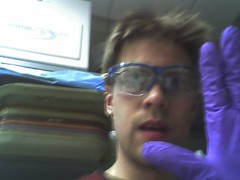Kiss-And-Run or Kiss & Sit?
Alright, so your promised Part Two (Electric Boogaloo) was slightly delayed by some mass confusion on my part. But I think I've got it all worked out now.
So, first some assorted backgrounds for the non-neuro-inclined:
The first thing you need to know about is the existence of neurotransmitters. Fortunately, you only really need to know a few things:
1. Neurotransmitters are chemicals neurons use to communicate with each other. This occurs at a junction between two parts of a cell known as a synapse.
2. The basic, watered-down version of transmitter release is as follows: inside the axon terminal a batch of vesicles sit around, full of transmitter. These are sitting, prepared to release their cargo into the synaptic cleft (the space between the presynaptic and postsynaptic parts). When the signal to release comes, the vesicle's membrane is joined with the plasma membrane, opening the vesicle to the synaptic cleft and allowing its contents to diffuse out.
What happens next? That's what we're here to talk about.
Really, what we're looking at here is an important question: what happens to the vesicle once its cargo is released? There are two main pathways we want to compare here. I'll give you a link now to this somewhat disturbing java animation that The Daily Transcript linked to when he posted about the article we're going to talk about.
So, in simplified terms, we're dealing with two pathways that are called "endocytosis" and "kiss and run". If you've taken some bio classes, you're probably at least acquainted with the idea of endocytosis. In this example of the scenario, the vesicle completely fuses with the plasma membrane of the neuron (known as exocytosis), which enables complete release of transmitter. Later, a chunk of membrane is pulled back in from the plasma membrane (via clathrin-mediated endocytosis--don't worry, you don't need to know this part) and fuses with a cell organelle known as the endosome. It's then recycled from the endosome and gets filled back up with all its neurotransmitter goodness, so it can re-dock and re-prepare to release it.
Now, this sounds like a lot of work, doesn't it? And you're right: this is a process that takes around a half a minute or so. And when you're thinking about the time frame on which your nervous system works, you're probably not thinking about taking a half minute to get anything done. Or maybe you are. We could agree to disagree on this. But that's where "kiss-and-run" comes in.
If I understand correctly, the idea of kiss-and-run was developed based on the observation that vesicles could reform in just a few seconds after a weak, transient stimulation. Basically, in kiss-and-run, it's thought that the vesicle "kisses" the membrane, transiently opening a pore which releases some of its transmitter load, before pulling back and "running" away. This way, instead of having to put a vesicle together from scratch at the endosome, you have a half-full vesicle that you can fill the rest of the way while it's sitting in line and waiting for it's turn to come around again. Under this hypothesis, the vesicular release via exocytosis and endocytosis only occurs during prolonged stimulation.
Now, from what I've seen, kiss-and-run has been fairly well demonstrated, although not conclusively so. This is going to be important when we get to Willig et al's paper, which is going to have to be part three of this series, because this post is already way too long.


0 Comments:
Post a Comment
Send Haloscan trackback ping
<< Home